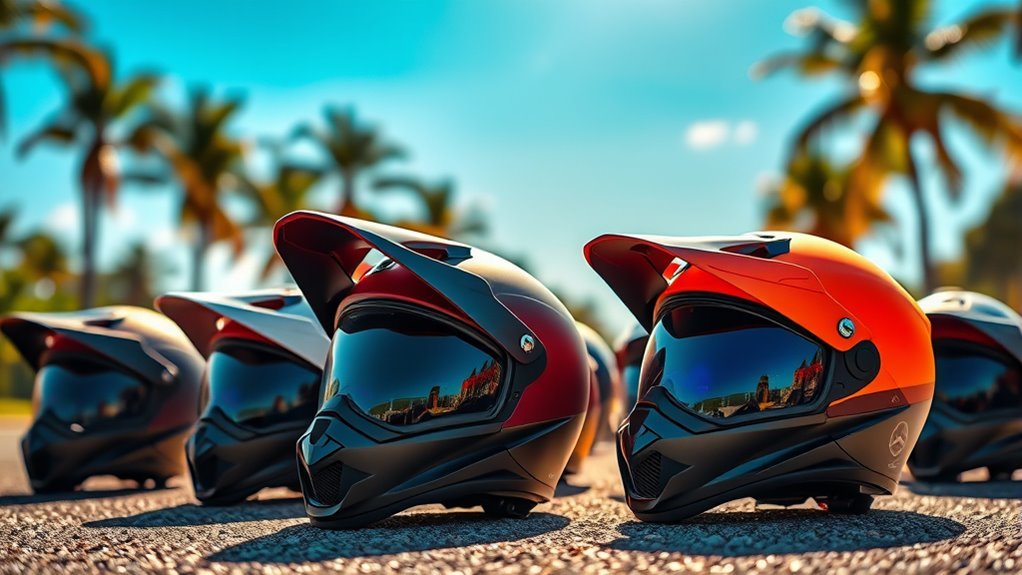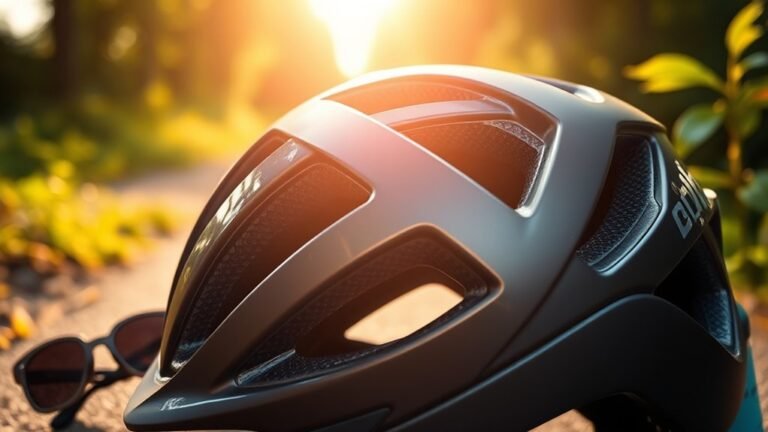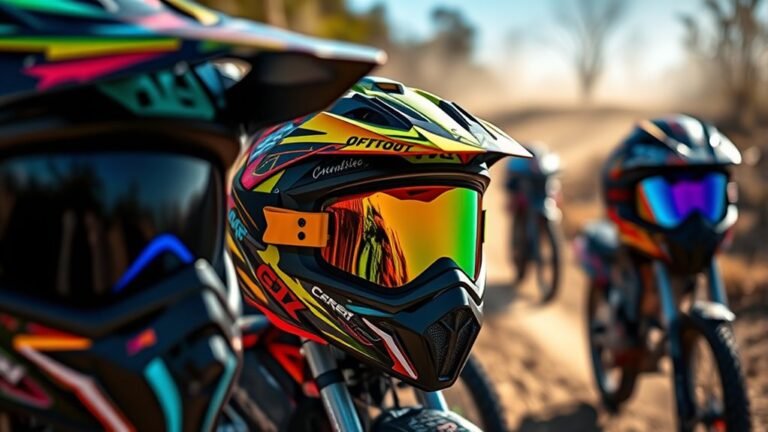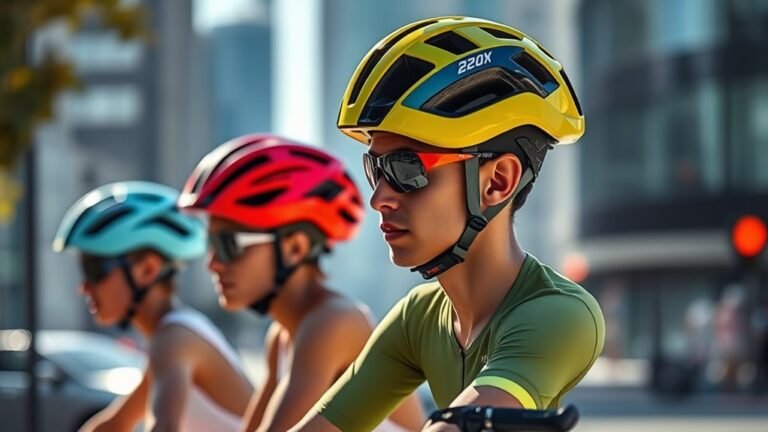Best Helmets for Hot Weather Riding
When choosing a helmet for hot weather riding, prioritize ventilation to enhance airflow and reduce heat buildup. Look for lightweight materials like polycarbonate or carbon fiber for comfort, and guarantee it has moisture-wicking liners to keep sweat at bay. Top options include the Arai XD4, Scorpion EXO-R420, and Bell Qualifier DLX, all known for their excellent ventilation and UV protection. Want to know about more options tailored for your needs? Keep going to discover further insights.
Importance of Ventilation in Helmets
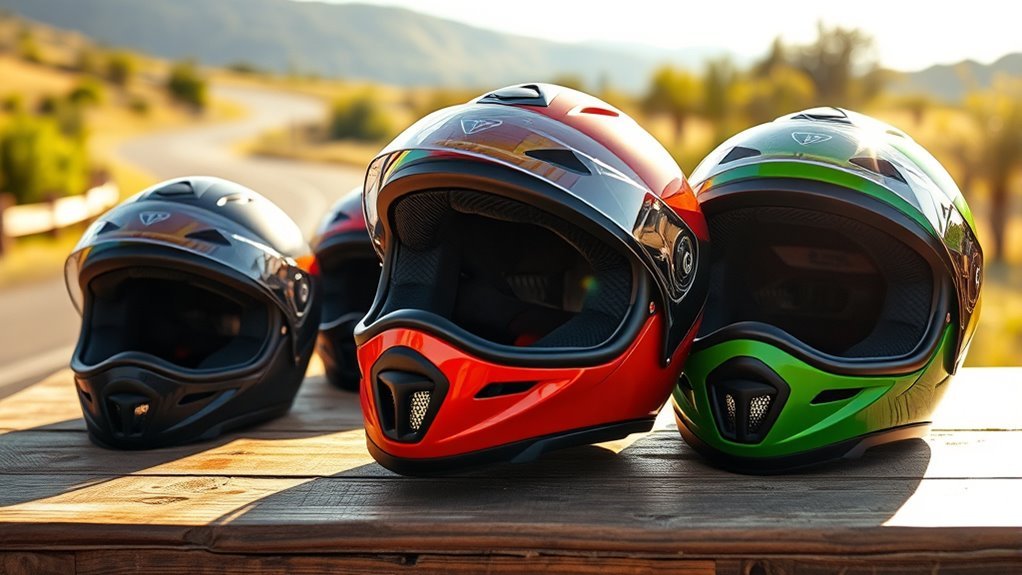
When you’re riding in hot weather, effective ventilation in your helmet isn’t just a comfort—it’s crucial for safety. Proper airflow dynamics allow heat to escape, keeping your head cool and focused on the ride. Helmets with advanced heat dissipation techniques, such as strategically placed vents, enhance airflow, reducing sweat buildup and preventing overheating. These features optimize your riding experience by promoting consistent air circulation, which is important during long journeys under the sun. A well-ventilated helmet not only improves comfort but also helps maintain your alertness and reaction time. When you choose a helmet, consider how its ventilation system supports your freedom to ride safely, allowing you to enjoy the open road without the hindrance of excessive heat.
Lightweight Materials for Comfort
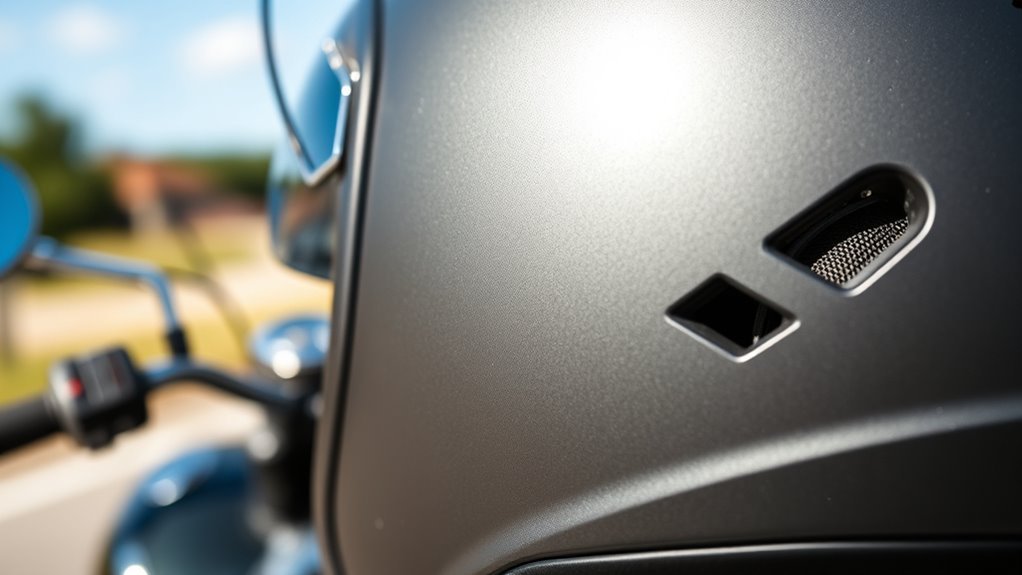
Choosing a helmet made from lightweight materials can greatly enhance your riding comfort, especially in hot weather. These materials, such as advanced polycarbonate and carbon fiber, reduce the overall weight of the helmet, allowing for a more enjoyable experience on the road. A lighter helmet not only minimizes fatigue but also aids in thermal regulation, keeping you cooler during long rides. When selecting a helmet, verify that it fits snugly without being constrictive; the right helmet fit is vital for both safety and comfort. You want a product that won’t shift while you ride, allowing you to focus on the freedom of the open road. Lightweight helmets provide an ideal balance between protection and comfort, making them essential for hot weather riding.
Moisture-Wicking Liners and Padding
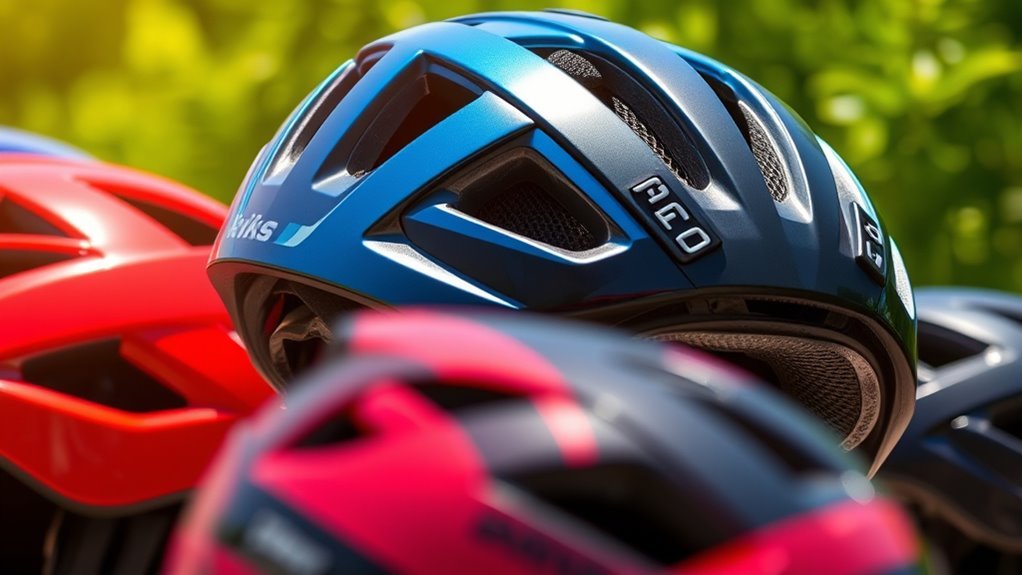
When riding in hot weather, having moisture-wicking liners and padding in your helmet is essential for comfort. These breathable materials help manage sweat, keeping you cool and dry while also offering antimicrobial properties to reduce odor. Choosing a helmet with these features can greatly enhance your riding experience.
Breathable Materials Importance
While riding in hot weather, the importance of breathable materials in your helmet can’t be overstated. Breathable fabrics are essential for maintaining comfort and safety during long rides under the sun. They facilitate airflow dynamics that help regulate your body temperature, preventing overheating. Good helmets use moisture-wicking liners and padding that keep sweat at bay, allowing you to focus on the road ahead without discomfort. When choosing a helmet, look for those made with advanced breathable materials that not only enhance ventilation but also contribute to a lightweight feel. This combination guarantees a pleasant riding experience, no matter how high the temperatures soar. Ultimately, selecting the right helmet with breathable features can make all the difference in your ride.
Antimicrobial Properties Benefits
Breathable materials aren’t just about airflow; they also play a key role in hygiene, thanks to antimicrobial properties found in moisture-wicking liners and padding. These features are essential for hot weather riding, where sweat can lead to discomfort and odor. With advanced antimicrobial technology, the liners actively combat bacteria and fungi, helping to maintain a fresh environment inside your helmet. This means you can focus on the ride without the distraction of unpleasant smells. Additionally, moisture-wicking padding enhances comfort by drawing sweat away from your skin, promoting quick evaporation. This combination not only guarantees odor control but also enhances your overall riding experience, allowing you to enjoy the freedom of the open road without worrying about hygiene.
Top Motorcycle Helmets for Hot Weather
Riding in hot weather can be challenging, but choosing the right motorcycle helmet can make all the difference in your comfort and safety. Here are some top helmet styles designed for hot conditions, offering excellent ventilation and sun protection:
| Helmet Model | Ventilation Features | Sun Protection Rating |
|---|---|---|
| Arai XD4 | Multi-directional air flow | UV protection 400 |
| Scorpion EXO-R420 | Large vents | UV protection 400 |
| Bell Qualifier DLX | Channeled airflow | UV protection 400 |
| HJC IS-MAX II | Adjustable vents | UV protection 400 |
| Shoei RF-1400 | Aerodynamic shell | UV protection 400 |
These helmets combine functionality with style, ensuring you stay cool and protected on the open road. Choose wisely for a more enjoyable ride!
Best Cycling Helmets for Hot Conditions
Choosing the right cycling helmet for hot conditions is vital for maintaining comfort and safety during your rides. When searching for a helmet, prioritize those designed with heat resistance in mind. Look for models featuring advanced ventilation systems that facilitate airflow, helping to keep your head cool. Comfort features, such as moisture-wicking pads and adjustable straps, can also enhance your riding experience. Lightweight materials are important, as they reduce fatigue over long distances. Helmets with a snug fit without compromising breathability guarantee maximum protection while allowing freedom of movement. By focusing on these elements, you can enjoy your rides even in the hottest weather, making sure both safety and comfort are at the forefront of your cycling adventures.
Off-Road Helmets Designed for Heat
While off-road riding can be exhilarating, the heat can quickly become a challenge if you don’t have the right helmet. Off-road helmets designed for hot weather prioritize ventilation and lightweight materials. Look for models with ample airflow channels and removable liners to keep your head cool. These helmets often incorporate off-road features like extended visors and enhanced chin guards, which provide protection while allowing heat to escape. The right helmet fit is essential; it should be snug but not overly tight, ensuring comfort during long rides. By choosing a helmet that balances protection and breathability, you can enjoy the freedom of off-road riding even in the sweltering heat without sacrificing safety or comfort.
Frequently Asked Questions
How Do I Properly Clean My Helmet to Maintain Ventilation?
To properly clean your helmet and maintain ventilation, start by using mild soap and warm water as your cleaning materials. Avoid harsh chemicals that can damage the helmet’s surface. Remove the inner padding and wash it separately. Rinse everything thoroughly and dry it with a soft cloth. Verify all vents are clear of debris to promote airflow. Regular helmet maintenance will keep it in top condition and enhance your riding experience.
Can I Use a Tinted Visor in Hot Weather?
Yes, you can use a tinted visor in hot weather. Tinted visors help reduce glare from the sun, improving visibility under bright conditions. However, make sure the tint complies with local regulations, as some areas have restrictions. Keep in mind that while a tinted visor can enhance comfort in sunny weather, it might also reduce visibility during low-light conditions, like dawn or dusk. Always prioritize safety and adjust your gear according to the weather conditions you’re facing.
Are There Specific Brands Known for Hot Weather Helmets?
When you think of freedom on the open road, a quality helmet is the key. Brands like Bell, Shoei, and Arai are well-known for their hot weather helmets. Look for models made from lightweight materials like polycarbonate or fiberglass, which offer ventilation without sacrificing safety. These brand recommendations guarantee you stay cool while enjoying your ride. Don’t forget, the right helmet not only protects but enhances your experience under the sun!
How Often Should I Replace My Helmet in Hot Climates?
You should replace your helmet every 3 to 5 years, especially if you’re riding in hot climates. The intense summer heat can accelerate material degradation, impacting your helmet’s lifespan and safety. Always inspect your helmet for any signs of wear, cracks, or damage after frequent use, and consider replacing it sooner if you’ve had a significant impact. Prioritizing safety guarantees your freedom on the road remains uncompromised.
What Are the Signs of Heat-Related Helmet Discomfort?
You might notice signs of heat-related helmet discomfort after just 30 minutes in extreme heat. Symptoms include excessive sweating, headaches, dizziness, and a feeling of heat exhaustion. If the helmet’s materials trap heat rather than dissipate it, you’re likely to feel uncomfortable quickly. Pay attention to these signs, as prolonged discomfort can lead to serious health risks. Staying aware can help you enjoy your rides without compromising your well-being.
